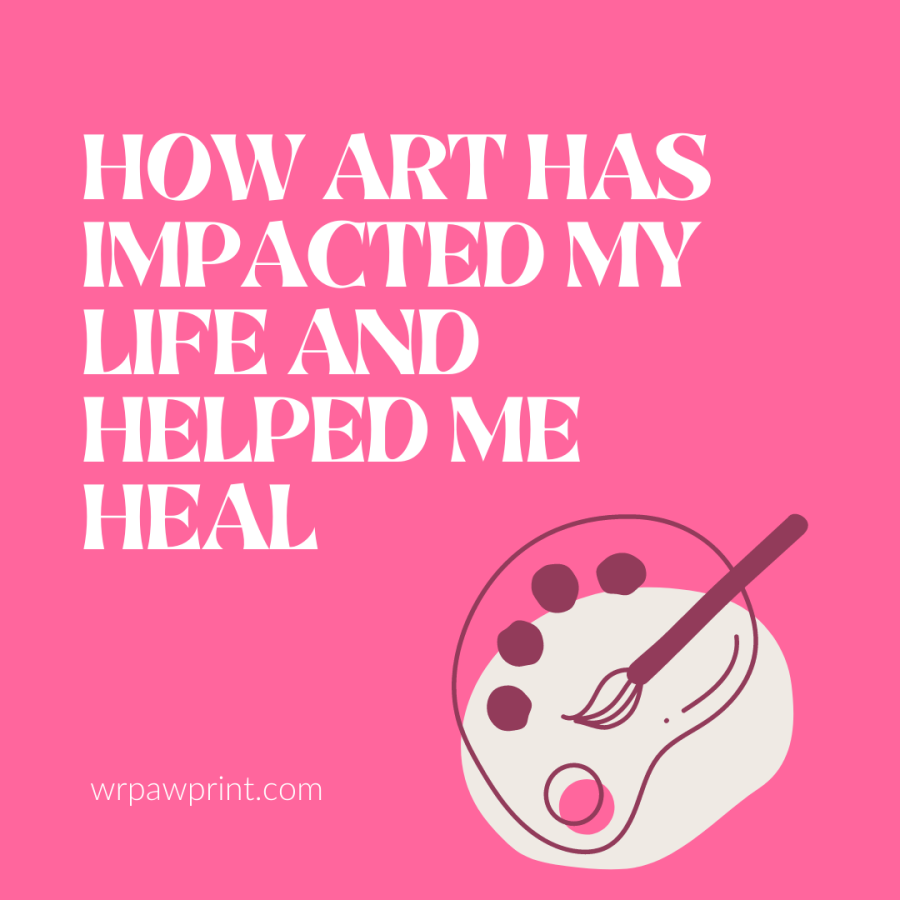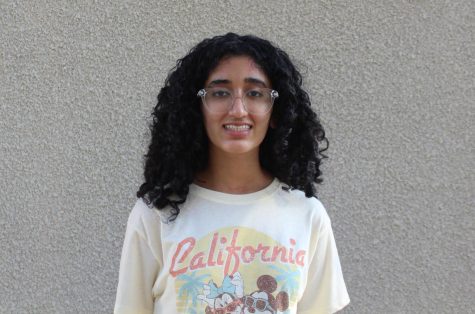How art has impacted my life and helped me heal
March 8, 2022
The year was 2015.
In the middle of the school year, I had to visit the doctor’s office—nothing much, just a normal, routine check-up.
I’ve had many of these check-ups over the years, as I was born with a rare genetic condition called Cowden Syndrome. It’s estimated that 1 in every 250,000 people have this disorder— it has a mile-long list of symptoms, but the main one is an increased risk of cancer.
A malignant tumor could pop up at any time, so I need to be carefully monitored to make sure that nothing potentially dangerous pops up.
This check-up was just like the other ones. I had some ultrasounds, appointments, blood tests and scans. Everything will be fine, I told myself. I took a deep breath.
And then, suddenly, everything wasn’t fine.
My worst nightmare had finally come to fruition, at a time when I could never have prepared myself to hear that word— cancer. I knew enough from what my mother told me about my condition that cancer could be a death sentence for me.
In my scans, my doctors found a tumor in my thyroid, the butterfly-shaped organ in my neck— a benign tumor, but nonetheless, one that was growing, and could develop into more aggressive forms of cancer.
I was grateful that the tumor had been caught early, so it hadn’t had that much time to develop. Even then, I remember when I first heard the results from my doctors, I became numb, and my face flushed cold.
The year after that passed by in a blur.
I had some biopsy tests done, and my results were sent all around the country, as doctors that I had never even met debated on whether or not to remove my thyroid in order to prevent the tumor from developing.
Finally, in the summer of 2016, a team of surgeons at CHLA decided to go forward with a thyroidectomy, and remove the organ entirely. Of course, this was a little difficult for me to hear as an eleven year old— I cried for a long time, and naturally, I was terrified.
Before my surgery, three of my teachers gave me a gift. I still remember my teacher’s voice— “From all of us, so you can have something to keep yourself occupied during recovery.”
I gratefully took the coloring book and 50-pack of Crayola markers.
Little did I know how much that gift would impact me.
After my surgery, the recovery process was long and tedious. I had to remain in inpatient care for several days— a seemingly endless nightmare. All around me, I could see so many other kids like me going through the same thing that I was. To this day, the sounds from the hospital still ring in my ears when I think about it— machines beeping, doors swinging as nurses and doctors walked in and out, and the occasional wailing of a child coming from down the hall.
Through all of this, I had to find something to keep myself occupied. My mind immediately went to the coloring book and markers. I opened it up and started coloring.
Immediately, I found that it made a sudden change in my mental state. The experience was so calming, and it was a great way to pass the time as I sat in bed, as it was extremely difficult to do anything else.
Later, I decided to explore art more, and moved into drawing.
Mind you, my family was surprised when they heard this. Before then, I had no experience in art whatsoever. I despised painting— I felt as though I had no control over what I was making. I wasn’t particularly interested in drawing, because I thought it was too tedious. But I decided to give it a try.
I started out with the basics and gathered whatever tools I had. I used online tutorials to start— I would look up a new character and carefully draw, trace and color it.
I continued to practice cartooning until two years later, when I signed up for an art class in junior high school. The teacher of the program encouraged us to explore and try new things, potentially failing along the way. In class, we worked with every medium imaginable— clay, acrylics, watercolors, pencils, you name it. Our homework each week was to complete one to two new pieces and post them on a class blog.
At first, I was afraid to make something that would look bad. Nevertheless, I bought a sketchbook and a pack of pencils, and on the first day, I tried creating my own characters.
When I brought the drawings to my teacher, she suggested, “Why don’t you also try portrait drawing? That will use a lot of the basics we’ve been learning in class.”
I thought about what she had said. Hesitantly, I decided to heed her advice, and give it a try.
First, I learned everything I possibly could about sketching. I taught myself the graphite grading scale, shading techniques, how to blend gradients, how to use charcoal and much more. Armed with new knowledge, I chose a reference I had always thought was a fascinating picture— Katniss Everdeen from The Hunger Games. Every day, I sat down with my sketchbook for several hours, and just drew what I saw on the screen in front of me.
It took me a couple of weeks, and I encountered some obstacles along the way. I had trouble making the facial features perfect. Drawing hands was an absolute nightmare. Nevertheless, I finally finished my first portrait drawing. Of course, it wasn’t perfect, since it was my first try. But I was proud of it, because it was something I had made through independently teaching myself.
I had already started to see how art had influenced me, and it changed my life for the better. I enjoy creating art because it’s an entertaining activity, but most importantly, it’s a way for me to clear my brain from the fog of stress. Practicing with face shapes and features gave me the discipline and patience to be able to finish a piece in its entirety. No longer did I start on one piece and then give up, which is what I was often tempted to do when I first started drawing.
And it isn’t just me— art is widely used to help people cope in difficult times, and it is well known for its positive effects on the body and mind.
According to the Mental Health Foundation of the UK, art is an effective treatment for any condition, and it plays a vital role through “offering help, promoting well-being and creating a space for social connection.”
Of course, there are a lot of different ways to engage with the arts, and it allows people to express emotions without ever saying anything. This can be done through creating diverse shapes and forms, and varying the usage of colors. All one has to do is put pencil to paper and create.
But how exactly does art help with mood? Making art triggers a release of dopamine, a feel-good hormone that increases blood flow to the pleasure and reward center of the brain. Dopamine is released when one engages in something that is pleasurable— in this case, putting a paintbrush to canvas, pencil to paper, or gouache to Bristol board. The release of dopamine produces a positive feeling, giving one a sense of accomplishment when finishing a creative endeavor. In addition, art also reduces cortisol, the body’s stress hormone, according to the American Congress of Rehabilitation Medicine.
Art is an ideal tool to help us feel happy and reduce stress. It offers us an outlet into something we can control, and it can be incredibly cathartic, because it allows us to cope with our emotions and express how we feel. Reducing cortisol and increasing dopamine gives us the feeling of pleasure that dopamine is responsible for. Essentially, it reduces anxiety and helps us cope with certain emotions during difficult times.
However, art isn’t only a great stress reliever.
As explained by the American Congress of Rehabilitation Medicine, “Art allows people to enter a “flow state,” or that feeling when you’re in the zone and lose sense of yourself and of time.”
Being in this “flow state” truly allows us to stretch our imaginations and explore the boundaries of our creativity— evolution plays a large part in this natural ability.
As stated in the Nature scientific journal, the need to produce art is a byproduct of survival adaptations, and it helped past humans survive, and show skills and intellect. Art allows us to play with patterns and process uncertainty. It applies the patterns of nature and allows us to connect emotionally.
Art requires a significant amount of planning and skill, and our unconscious motivations and preferences are constantly guiding the choices we make when creating a piece.
According to NPR, “When you make art, you’re making a series of decisions— what kind of drawing utensil to use, what color, how to translate what you’re seeing onto the paper. And ultimately, interpreting the images— figuring out what it means.”
Basically, our brains are trying to imagine new possibilities and look to the future beyond our current situation. Once we start making art, we can give our imaginations the creative freedom for constructing our different interpretations of the future. Once we are able to visualize what our future can look like, we can make these different interpretations a reality.
And it doesn’t matter whether the art is “good” or “bad”— really, there is no such thing. It doesn’t matter whether one is a beginner or expert. It can be a coping mechanism for anyone. It can boost confidence in anyone, and it can benefit anyone. Most importantly, you don’t need to be a master to get started. All you need is a pencil, paper, and your imagination.
This is why art can be so useful when going through tough times, or just going through life, in general. It can strengthen bonds in a community, and it allows people to emotionally connect with one another.
It truly makes a deep psychological impact on us by giving us emotional freedom. It helps us organize our thoughts, and, by unleashing our imagination and creativity to cross new boundaries, art allows us to visualize a better future, and then make it happen.
As painter Joan Miró once said, “A simple line painted with the brush can lead to freedom and happiness.”
As an artist, I would say my main takeaway from my experiences would be that people shouldn’t be afraid of trying to make a piece of art. It never has to be perfect— but what it should do is allow you to expand your creativity and look at the world in a new way.
So, I would encourage everyone to try it. Who knows? Perhaps you might be the one to create that new world.


